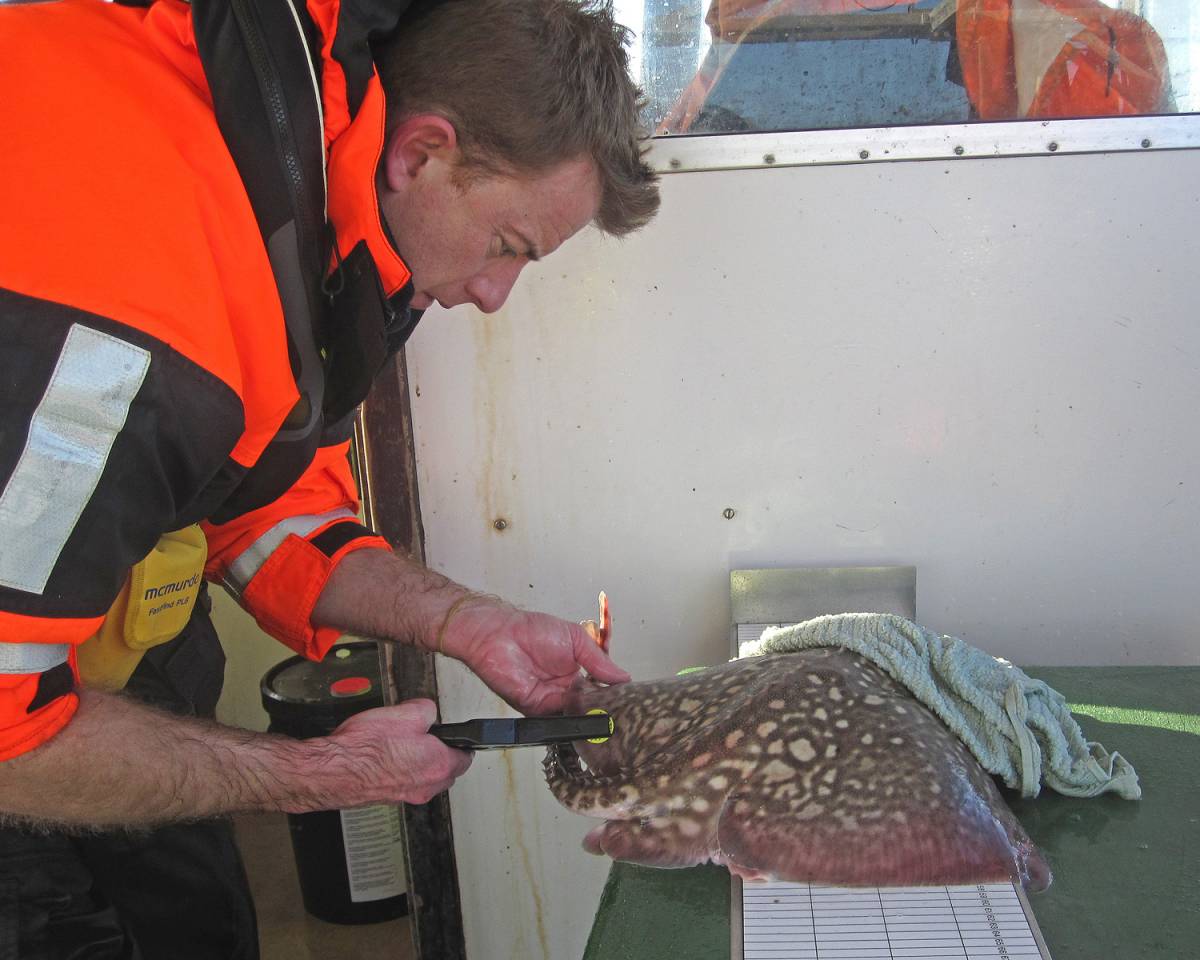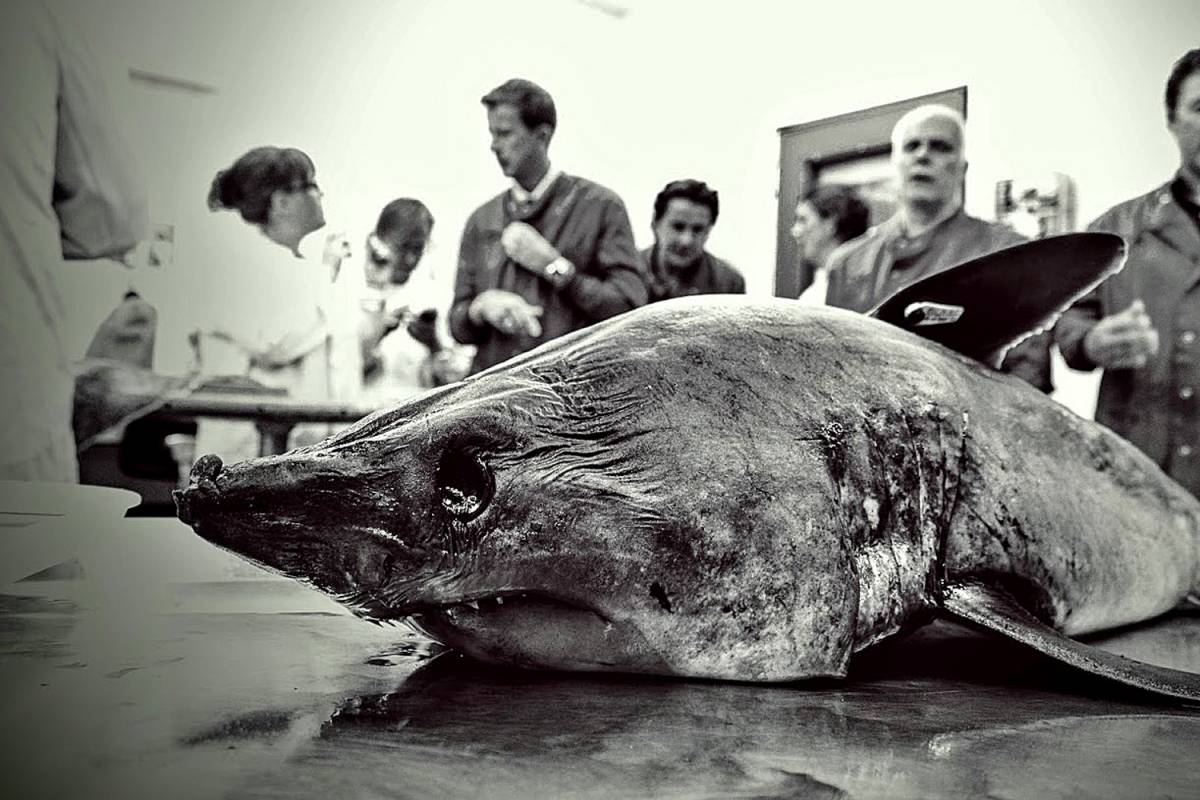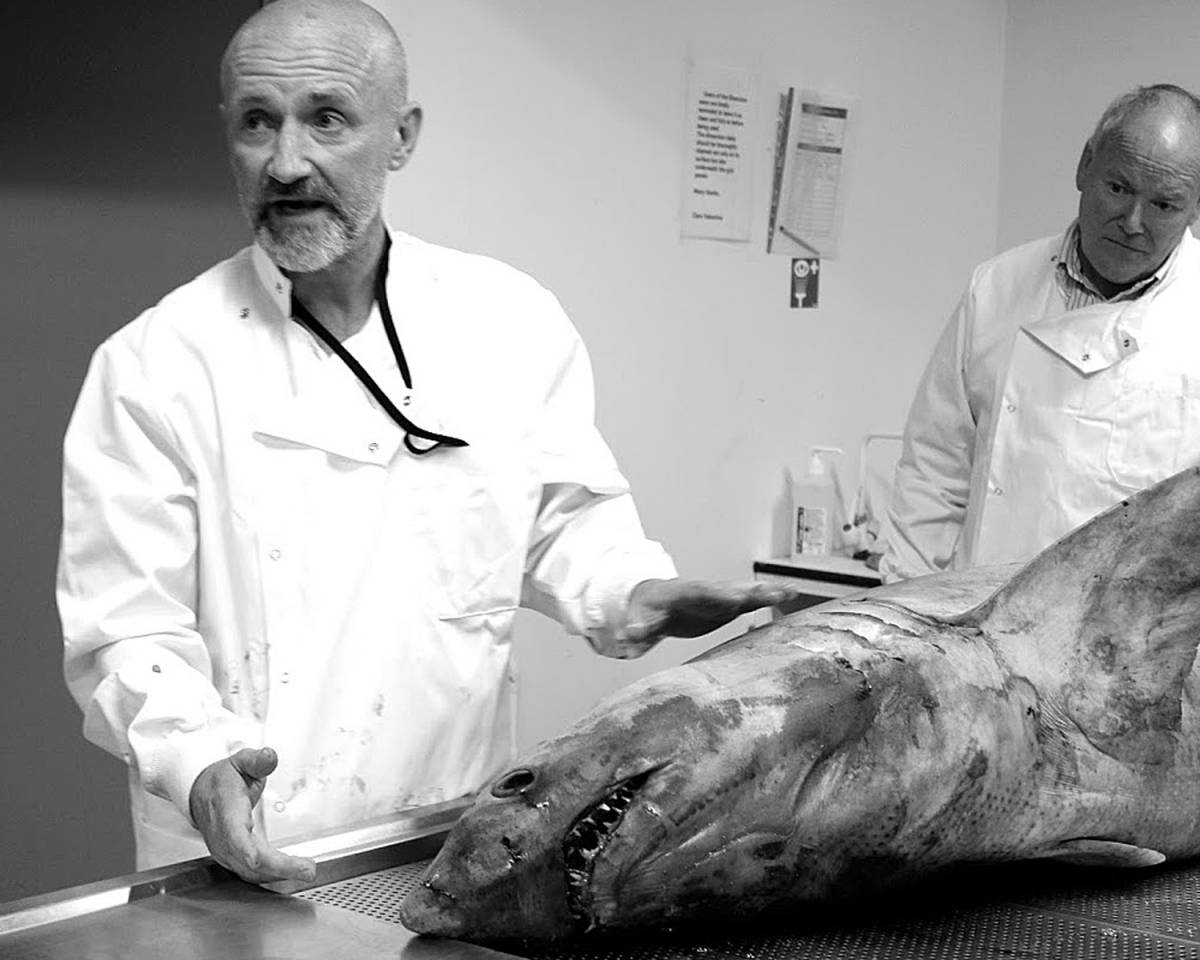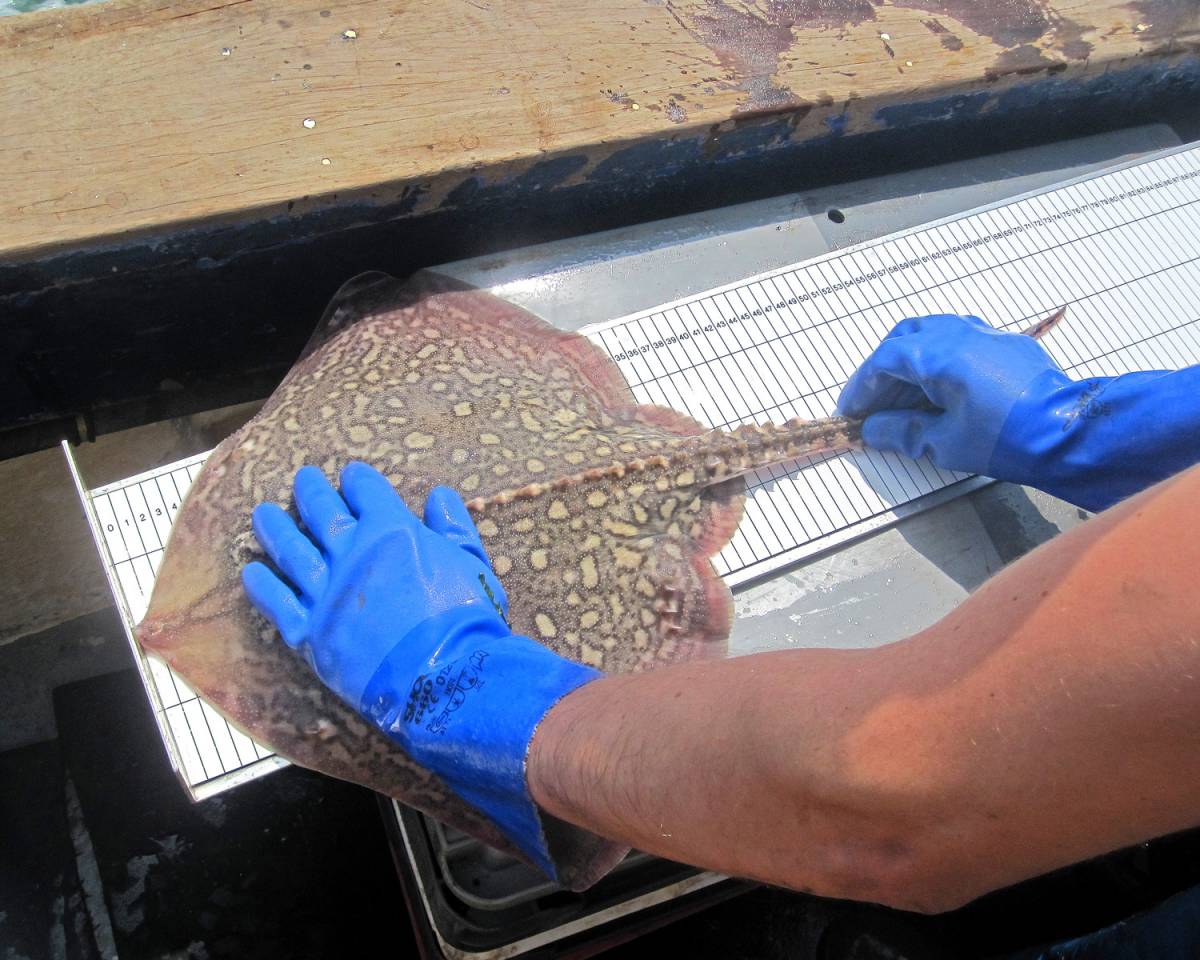Designed from the outset as a bottom-up initiative, instead of the more familiar top-down approach, the second phase of the CEFAS-led Shark By-Watch UK project builds on the success of its initial research, which saw commercial fishermen gather biological data on more than 8,000 elasmobranchs (sharks, skates, and rays). Shark By-Watch UK 2 has set out to involve fishermen in producing data, and also address their concerns about by-catches and the difficulties facing them.
Above: A spurdog is caught, tagged, measured and released.
One of the key issues that the project sets out to focus on is the lack of data on elasmobranch populations in UK waters; a data-deficit which can trigger precautionary measures often seen by the industry as being both highly-punitive and ineffective. As well as the issue of data deficiencies, a high level of these species in a boat’s catch can have economic implications, in terms of gear damage, or lost fishing time due to having to clear gear of unwanted by-catches.
The reformed CFP also presents new challenges; not least the landing obligation that is being phased-in between now and 2019 for demersal fisheries. Although this applies to TAC species, and not prohibited species such as porbeagle, which will still have to be discarded, targeted fisheries such as skates and rays will be included in the discard ban by 2019 at the latest.
There are concerns that elasmobranch species subject to small or zero TACs, such as spurdog, could become choke species, and there is also a need for longer-term research, such as to establish survival rates for sharks, skates and rays that are returned to the water alive.

CEFA scientist Stuart Hetherington attaches a tag to a ray.

Hauling the catch during a participatory research study.
Industry engagement
CEFAS marine biologist Stuart Hetherington, who has been co-ordinating the project, commented that many shark, skate and ray species, such as blonde ray, common skate and porbeagle, are among the most data-deficient species in UK waters, as research has traditionally focused strongly on commercial species such as cod, haddock and sole.
“We set out to work with fishermen who have knowledge of their own fishing grounds, to gather data and present it in a way that can be used by policy,” he said.
A series of consultation meetings was held, at which fishermen expressed their concerns about the CFP and the discard ban, as well as discussing their knowledge of shark, skate and ray species. As a result, areas in the Thames, the Wash and the Bristol Channel were identified as being worthy of particular attention.
The CEFAS team took the fishermen’s information and presented it in a format with specified goals. This resulted in one boat in the Bristol Channel, three in the Wash and four in the Thames gathering data during their usual fishing activity, overseen by the scientific team. The fishing vessels in the Thames Estuary covered a grid pattern across their fishing grounds, as a way of improving understanding of the abundance and distribution of thornback ray. “We asked them not to concentrate on the areas where they know they can always find fish, but to go to every square on the grids,” Stuart Hetherington explained.
“There has been very good engagement on this, with varying levels of success. It’s easier for trawlers to do this kind of work, as they have some hours between shooting and hauling their gear to go through the catch, but for single-crewed line-boats, with fish coming over the hauler continuously for several hours, this kind of work is less easy. But, in general, they did an outstanding job. All data is of value, but some were able to come up with more data than others,’ he said, and added that CEFAS is now working through the data and a report is expected in February.
This collaborative project, examining the interactions between sharks, skates and rays in UK waters and commercial fishing gears, has involved a number of agencies and individuals, ranging from fishermen, scientists, DEFRA, NGOs and retailers such as Morrisons, which has annual sales of 150 tonnes of skate wing.
“The priorities centre around research methodology, gear innovation and new management strategies,” Stuart Hetherington said. “Recommendations have been put forward as a way of proactively tackling the environmental and economic challenges posed by elasmobranch by-catches in UK fisheries, and to contribute to the successful implementation of the landing obligation.”

A by-caught porbeagle, legally landed under a special scientific licence, was the centrepiece of a live biological sampling held during the workshop.

An event held at the Natural History Museum, bringing together Shark By-Watch UK 2 stakeholders to witness a biological sampling of a legally-landed, by-caught porbeagle.

A participatory Shark By-Watch UK 2 workshop, hosted in partnership with the Zoological Society of London, brought together fishermen, policy makers, scientists, NGOs and others to discuss by-catch of elasmobranch species.
Gear recommendations
Recommendations have already been made on several species of conservation concern; common skate, porbeagle, basking shark and spurdog, which can appear as by-catch – particularly spurdog, with all the problems that a haul of these can bring for a small trawler.
“We’ve been very involved with the fishermen in the South-West on this, working on ways to minimise spurdog by-catches with the Spurdog By-catch Avoidance Programme. This is a real-time reporting tool which, rather than closing areas to fishing, has skippers reporting in about when, where, and in what volumes they have encountered concentrations of spurdog, making it possible for other boats to avoid them,” Stuart Hetherington said.
“This approach relies on skippers participating voluntarily, possibly moving to less-productive fishing grounds, which can be seen as an additional burden, both in time and loss of earnings. To work effectively, this approach needs to be incentivised, possibly through the provision of a small, marketable, dead spurdog by-catch allowance, to account for unavoidable by-catch. This proposal is being funded and explored by DEFRA.
“For the other three species that are caught more in static gear, there are fewer apparent solutions, but gear modifications could be one of them,” he said. These include weak links in mesh panels or joining fleets of nets, allowing porbeagles and basking sharks to break free of entanglement, and for similar weak links in negatively-buoyant creel ropes, to prevent basking shark entanglements in creel fisheries around the Western Isles. For common skate, selectivity grids in trawl gears are recommended for further investigation and field trials in UK waters, before they can be put to widespread use.
The Spurdog By-catch Avoidance Programme is already being trialled in the Celtic Sea offshore gill-net fishery, adapting the format used for real-time closures for cod in the North Sea, and the highly successful real-time by-catch avoidance system that has worked well in the US scallop fishery. If successful, two additional areas where similar approaches could be rolled out are the southern North Sea, where under-10m longliners target cod, thornback ray and bass, and the Western Isles Nephrops fishery. In the southern North Sea spurdog is a problem between November and April, when levels of by-catch and discarding become an issue, and in the Western Isles there can be regular spurdog by-catch episodes between October and January.

Stuart Hetherington of CEFAS, explaining the state of shark stocks in UK waters.

A fisherman measures a ray as part of a data collecting trip for Shark By-Watch UK 2.

Rays are measured as part of a participatory study.
Open and transparent
“The focus is also on thornback ray, and we have been looking at this in the light of the CFP reform and regionalisation. For the Thames under-10 fleet there is a high discard rate of thornback ray, so fishermen and the Kent and Essex IFCA has been gathering data, and looking at alternative management techniques,” said Stuart Hetherington.
“We’re looking at opportunities to manage this differently. The questions are whether or not this is a regional stock, and if it can managed regionally, not with traditional closed areas, but using spatial and temporal management instead. But we need to have the data to be able to answer those questions.”
He commented that shallow waters are not necessarily the best places for research vessels to operate, making co-operation with inshore fishermen on their own vessels an ideal option to gather data on whether or not thornback ray gather on banks or in deeper water at various times.
“This is an initiative that has come largely from fishermen themselves,” he said, admitting that, to begin with, things didn’t go entirely smoothly but have developed well.
“The ethos of this is very much that the data belongs to the fishermen as much as it does to CEFAS. This is an open, transparent, reiterative process, and the data is all there and will be available to them on the CEFAS data hub from March. So if any of the fishermen need to use that data, to approach the IFCA, for example, it will be there.”
Read more from Fishing News here.








